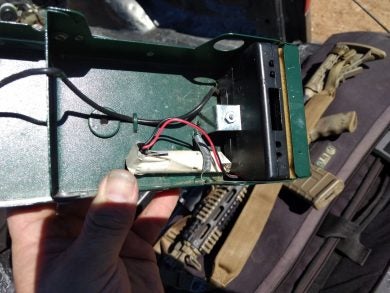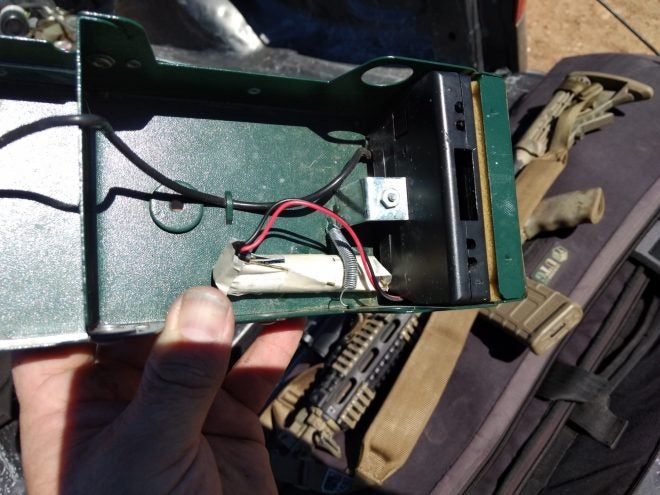One of my favorite TV shows is Red Green. For a Canadian, that guy is alright. If you haven’t had the pleasure of his manly wit, you really ought to take a moment to watch a few episodes. Like a real life version of Red Green, the YouTuber AvE has taught me not to be afraid to make broken things “chooch”. Of course, I’m not nearly as technically sound as he is, but I can maths just a little bit. On a recent range trip I discovered that my trusty Chrony brand chronograph had been left on from the previous range trip and the battery was dead. But channeling the spirit of Red Green, AvE, and MacGruber, I removed the batteries from my flashlight and used them to power the chronograph.

Making it work.
The flashlight was powered by two CR123 3 volt lithium batteries and the chronograph was powered by one 9 volt alkaline battery. I cut and bent the temple from an old pair of broken sunglasses to connect the negative terminal on the chronograph to the cathode of one battery, taped both batteries together in series, and taped the positive terminal to the anode of the other battery. It was ugly and sloppy. But it worked, as you can see below. If it’s stupid and it works, it’s not stupid.


Now, this is a gun blog, not an electronics blog, but on the off chance that you’re curious, why do you suppose that this worked? 6 volts does not equal 9 volts, does it? A chronograph is really just what it sounds like: a clock. The battery powers two light sensors, a clock, a display, and a chip that does a quick calculation. The clock starts* when one sensor detects a change in ambient light and stops when the other sensor detects a change. Those components can still run when the 9v is mostly discharged at 6 or 7 volts and the brand new CR123 batteries actually measure a little higher than their nominal 3 volts. In short, close enough is often good enough. Sure, it’s possible to damage things this way, so maybe you shouldn’t take this as a Pinterest life hack. But given that the voltage of the CR123 in series was lower than the nominal 9 volts the chronograph was designed for, and given that batteries typically just push whatever amperage that the equipment is pulling, it was most likely not going to cause any damage.
*Gross oversimplification. If you really want to go full nerd, on the chip level, it actually counts how many clock cycles (highs) occur between the high signal from one sensor and from the other. There is some other simple logic involved to avoid anomalous readings.
 Your Privacy Choices
Your Privacy Choices
